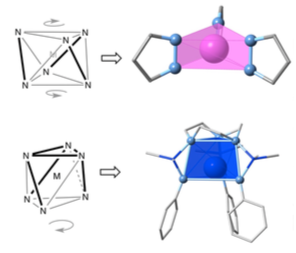Distortion Pathways of Transition Metal Coordination Polyhedra Induced by Chelating Topology
Distortion Pathways of Transition Metal Coordination Polyhedra Induced by Chelating Topology
S. Alvarez.
Chem. Rev., published ASAP (2015). Doi: 10.1021/acs.chemrev.5b00537

A continuous shape measures analysis of the coordination polyhedra of a host of transition metal complexes with bi- and multidentate ligands discloses the distortion pathway associated with each particular topology of the chelate rings formed. Since the degree of distortion within each family of complexes depends on the atomic size, on which the high- or low- spin state has a large effect, the analysis presented is specially interesting to identify distortions that go along with the transition from low to high spin state affected by temperature, light or pressure. Deviations from the expected distortion pathways in the high spin state are shown to be associated to the onset of intermolecular interactions such as secondary coordination of counterions or solvent molecules. Also significant displacement of counterions in an extended solid may result from the changes in metal-ligand bond distances when ligands are involved in intermolecular hydrogen bonding.
